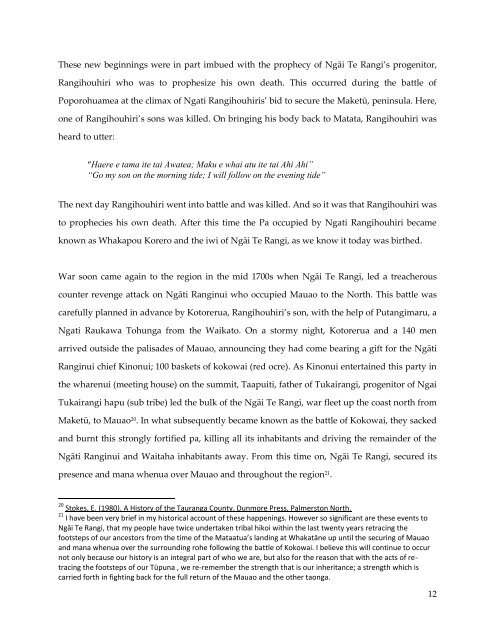LEWIS WILLIAMS, PHD
LEWIS WILLIAMS, PHD
LEWIS WILLIAMS, PHD
You also want an ePaper? Increase the reach of your titles
YUMPU automatically turns print PDFs into web optimized ePapers that Google loves.
These new beginnings were in part imbued with the prophecy of Ngāi Te Rangi’s progenitor,<br />
Rangihouhiri who was to prophesize his own death. This occurred during the battle of<br />
Poporohuamea at the climax of Ngati Rangihouhiris’ bid to secure the Maketū, peninsula. Here,<br />
one of Rangihouhiri’s sons was killed. On bringing his body back to Matata, Rangihouhiri was<br />
heard to utter:<br />
“Haere e tama ite tai Awatea; Maku e whai atu ite tai Ahi Ahi”<br />
“Go my son on the morning tide; I will follow on the evening tide”<br />
The next day Rangihouhiri went into battle and was killed. And so it was that Rangihouhiri was<br />
to prophecies his own death. After this time the Pa occupied by Ngati Rangihouhiri became<br />
known as Whakapou Korero and the iwi of Ngāi Te Rangi, as we know it today was birthed.<br />
War soon came again to the region in the mid 1700s when Ngāi Te Rangi, led a treacherous<br />
counter revenge attack on Ngāti Ranginui who occupied Mauao to the North. This battle was<br />
carefully planned in advance by Kotorerua, Rangihouhiri’s son, with the help of Putangimaru, a<br />
Ngati Raukawa Tohunga from the Waikato. On a stormy night, Kotorerua and a 140 men<br />
arrived outside the palisades of Mauao, announcing they had come bearing a gift for the Ngāti<br />
Ranginui chief Kinonui; 100 baskets of kokowai (red ocre). As Kinonui entertained this party in<br />
the wharenui (meeting house) on the summit, Taapuiti, father of Tukairangi, progenitor of Ngai<br />
Tukairangi hapu (sub tribe) led the bulk of the Ngāi Te Rangi, war fleet up the coast north from<br />
Maketū, to Mauao 20 . In what subsequently became known as the battle of Kokowai, they sacked<br />
and burnt this strongly fortified pa, killing all its inhabitants and driving the remainder of the<br />
Ngāti Ranginui and Waitaha inhabitants away. From this time on, Ngāi Te Rangi, secured its<br />
presence and mana whenua over Mauao and throughout the region 21 .<br />
20 Stokes, E. (1980). A History of the Tauranga County. Dunmore Press, Palmerston North.<br />
21 I have been very brief in my historical account of these happenings. However so significant are these events to<br />
Ngāi Te Rangi, that my people have twice undertaken tribal hikoi within the last twenty years retracing the<br />
footsteps of our ancestors from the time of the Mataatua’s landing at Whakatāne up until the securing of Mauao<br />
and mana whenua over the surrounding rohe following the battle of Kokowai. I believe this will continue to occur<br />
not only because our history is an integral part of who we are, but also for the reason that with the acts of retracing<br />
the footsteps of our Tūpuna , we re-remember the strength that is our inheritance; a strength which is<br />
carried forth in fighting back for the full return of the Mauao and the other taonga.<br />
12


